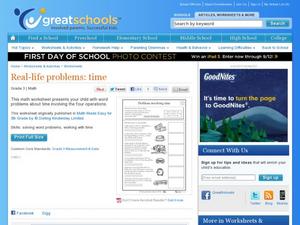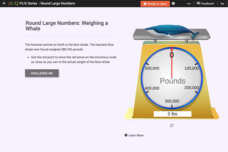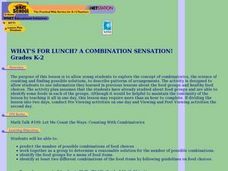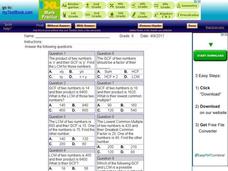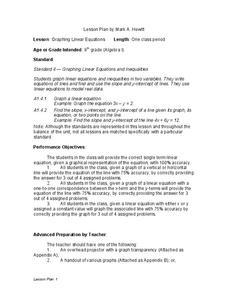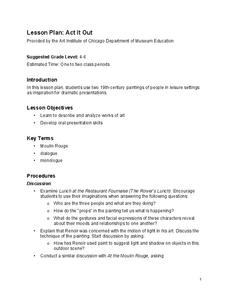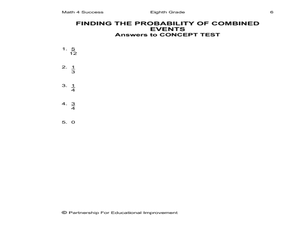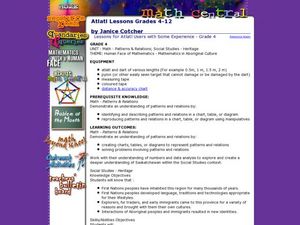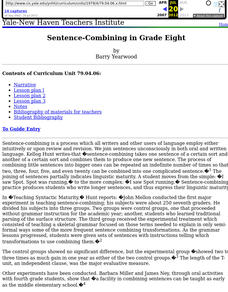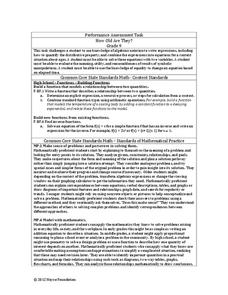Curriculum Corner
7th Grade Math "I Can" Statement Posters
Translate the Common Core math standards into a series of achievable "I can" statements with this collection of classroom displays. Offering posters for each standard, this resource is a great way to support your seventh graders as...
Canadian Museum of Civilization Corporation
Artifacts Tell Stories: Creating a First World War Museum in the Classroom
Although designed for the Canadian War Museum, the concept here is a solid one. Class members select an artifact from the First World War, examine it, research it, and craft an explanative label that they attach to their picture and post...
Curated OER
Real-Life Problems: Time
Combine word problems, telling time, and the four operations. Six problems prompt third graders to write out and solve word problems involving time and timing. Can they finish all six on their own or with a partner?
CK-12 Foundation
Large Decimal Rounding to Decimal Representations: Weighing a Whale
An interactive challenges mathematicians to round large numbers with help from a large scale that measures the weight of a blue whale. The practie's five questions include multiple-choice, fill-in-the-blank, true or false, and an open...
Curated OER
Fractions of Shapes
Modelling fractions through shapes is a great way to demonstrate this concept to beginners. Learners examine 12 shapes, each divided into an even number of equal segments (up to 16 parts). They shade in half of each shape by shading half...
Curated OER
5th grade science review
In this science review instructional activity, 5th graders answer questions about molecules, force, elements, nature, and more. Students complete 25 multiple choice questions.
Curated OER
What's For Lunch? A Combination Sensation!
Students combine different foods to make possible lunches and determine the specific combinations of lunches that can be made from a finite set of foods.
Curated OER
Relating GCF and LCM for Grade Six
In this relating GCF and LCM for Grade Six worksheet, 6th graders answer ten multiple choice questions about factors and multiples, with answers available onscreen.
Curated OER
Grade 2: Spinning Sums
Second graders collect data by spinning two spinners and creating sums, organize the data, and make conclusions from the data. Each students makes a spinner. They spin and record the number of the section each time. Students work in...
Curated OER
Multiplication Lesson Plan
Students roll dice to come up with 1 digit numbers that they multiply together. In this multiplication lesson plan, students arrange piles of blocks and count them to complete problems.
Curated OER
Graphing Linear Equations
Ninth graders review the information that they have already learned
with regard to linear equations and graphical representations. They then assist in combining equations with a graphical element and complete various graphs with this...
Safe Drinking Water Foundation
Demonstration of Water Pollution
In this teacher-led demonstration, your young environmentalists will observe and record how different types of water pollutants look when they are combined. From here, individuals will develop a hypothesis on how the water can be...
Captain Planet Foundation
Square Foot Fall Garden
First graders learn the basic needs of plants and identify geometric shapes while planting a fall garden. Combining math and science in one lesson, the resource guides kids through starting their class garden as they...
Curated OER
Solar-Powered Prints
Combine art and science with this fabulous lesson plan where your class will create solar-powered artwork! They will create a cyanotype, using photo-sensitive paper, sun, and water. A list of necessary materials is provided.
Dick Blick Art Materials
Simple Suminagashi
Go ahead. Spill the ink! Combine the study of art, social studies, and science with a Suminagashi (spilled ink) activity that produces "unique and unreproducible" works of art.
Art Institute of Chicago
Act It Out
Examine two works of art and use these pieces as inspiration for dialogues. The whole class discusses Renoir's Lunch at the Restaurant Fournaise and Toulouse-Lautrec's At the Moulin Rouge. Then, in groups of either three or ten, pupils...
Curated OER
Solving Multi-Step Equations (Ch. 2.3)
Eighth graders solve multi-step equations, showing each step in their solution. This multi-step equations lesson includes sample problems to complete as a class, clear step by step instructions for the student and a linked comic strip...
Curated OER
Combining Elements to Form a Compound
Learners explore elements and compounds. In this instructional activity about elements and compounds, students will do an experiment. Learners work in groups of 2-3 as they complete two separate activities. Students understand how two...
Curated OER
Language Practice #6: Grades 3-4
In this language practice worksheet, students fix sentences, identify nouns, verbs or adjectives and combine sentences.
Curated OER
Finding the Probability of Combined Events
Eighth graders investigate the probability of combined events. In this eight grade probability instructional activity, 8th graders use a sample space, two events, and their intersections to determine the probability of each event,...
Curated OER
Atlatl Lessons for Grade 4
Fourth graders explore the weapons of the Aboriginal people. In this fourth grade math lesson, 4th graders create charts, tables, or diagrams to represent patterns and relations. Students investigate which dart length has the...
Curated OER
Sentence-Combining in Grade Eight
Eighth graders examine and discuss signaled sentence-combining. They read sentences and then combine them. They revise paragraphs from their own compositions using sentence-combining.
Inside Mathematics
How Old Are They?
Here is a (great) lesson on using parentheses! The task requires the expression of ages using algebraic expressions, including the distributive property. Pupils use their expressions to determine the individual ages.
EngageNY
Solving Percent Problems III
What happens when combining percentage discounts? The last lesson in a series of 29 introduces the idea of combining discounts one after another. Pupils wrestle with the claim that to find the total discount, they need to only add...


